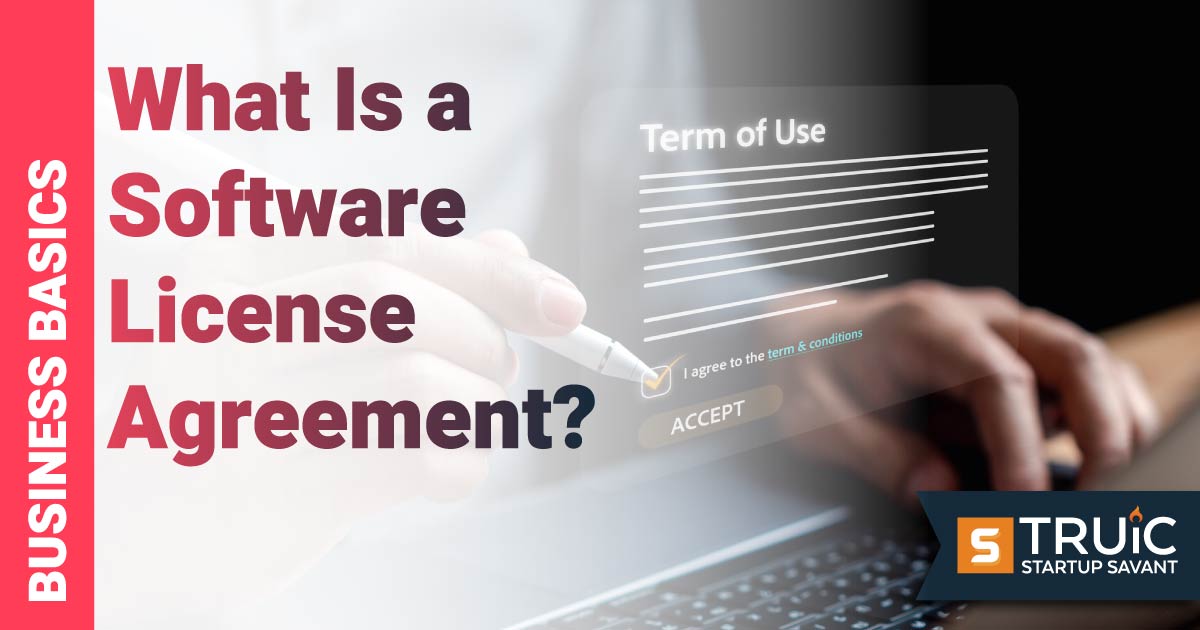What Is a Software License Agreement?

Last Updated: By Madison Holt
A software license agreement is a contract between a software developer and a third party that allows that third party to use the software without owning it. Because the developer retains ownership rights, they can sell licenses to multiple users, control where and how the software is installed, etc.
Startups need to know the ins and outs of software license agreements before they bring their software to market. In this guide, we explain what software license agreements do, why they’re important, and how to create them.
Understanding Software License Agreements
A software license agreement is a legally binding contract between you and your customers that allows you to state in detail how they can use your software while letting you keep ownership rights. For example, you can specify:
- Where customers can install your software, including on how many devices
- How often customers can install it
- What customers will pay to use it, including whether they pay per user, per machine, etc.
- Whether and how customers can copy, modify, and/or redistribute the software
It’s important to properly craft a license agreement and require each of your customers to sign it before using your software. This will ensure that you’re paid for your product and will help protect you from copyright infringement (more on this below).
Types of Software License Agreements
Software license agreements come in three main types based on whom the license is being granted: a single user, multiple users, or an entire company (called an enterprise license). These agreements can use a number of different licensing structures:
- Perpetual Licensing: This is one of the most common types of licensing models. It allows the licensee to buy the software once and keep it as long as they wish, sometimes with an annual fee.
- Concurrent Licensing: Allows licensees to buy multiple licenses for a software platform at once – for example, so all of their employees can use the software under one licensing code.
- Subscription-Based Licensing: This is also a popular way to license software and involves the licensee paying a subscription fee (usually monthly or annually).
- Proprietary Licensing: Used by most software licensing models, proprietary licensing simply means the software developer retains ownership.
- Floating Feature Licensing: Floating feature licensing is similar to concurrent licensing in that the user can purchase multiple licenses. The main difference is that the software developer can limit which features that particular customers use, allowing customers to purchase only the features they need.
- Cloud-Based Licensing: If your software is cloud-based, consider a cloud-based licensing structure that lets your customers use it anywhere they have an internet connection.
EULA vs. Software License Agreement
An end-user license agreement (EULA) and a software license agreement are similar in that they both govern how a customer can use licensed software. They differ in terms of who they’re intended for.
An EULA generally specifies how a group of people can use software on a continuous basis. By contrast, a software license agreement determines how a specific company or organization can use the software for a specific period of time.
Another difference is that an EULA typically involves an intervening third party between the software developer and the end user. For example, if your company creates an app that will be sold on the Apple App Store or Google Play, that requires an EULA because Apple or Google is the intervening third party that sets rules you need to follow.
A software license agreement, on the other hand, is a direct contract between you as the software developer and your customer. That allows you to retain ownership and gives you more control over how your software is installed and used.
Components of a Software License Agreement
There are many components of a well-drafted software license agreement.
Definitions: Includes definitions of key terms to ensure everyone is on the same page.
Grant of License: Specifies the type of license being granted, such as a single-user license, multi-user license, or enterprise license; also outlines the scope of the license, including any general limitations on how the software can be used.
Permitted Uses: Specifies how the software can be installed, reproduced, distributed, modified, or otherwise used by the licensee(s).
License Fees: Specifies costs to the licensee, including upfront fees, ongoing subscription fees, and payment terms.
License Term: Specifies how long the license lasts (e.g., after a set time period or perpetually).
Renewal and Termination: Details how the license can be renewed and the conditions under which it can be terminated, such as for failing to pay the subscription fee.
Intellectual Property Rights: Clarifies who owns the software and any associated intellectual property, such as copyrights, trademarks, and patents.
Data Protection: Covers any legally mandated cybersecurity requirements related to data protection, data breaches, etc.
Restrictions: Lists the activities and uses that are explicitly prohibited, such as reverse engineering, decompiling, or sublicensing.
Support and Maintenance: States what support and maintenance services the software developer provides (if any), including the cost of those services, response times, etc.
Updates and Upgrades: States whether updates and upgrades to the software are included in the license or available separately and under what conditions.
Warranties: Addresses any warranties or guarantees provided by the software developer (or states that there are none).
Limitation of Liability: Sets limits on the developer's liability if the software allegedly causes damages; also includes provisions for indemnification and remedies for breaches.
Confidentiality: Outlines how the parties should handle confidential information.
Governing Law and Jurisdiction: Specifies the legal jurisdiction under which disputes will be resolved and the governing law that will apply.
Why Are Software License Agreements Important?
Software license agreements are important for startups and any other company because they protect your intellectual property rights as a software developer while also granting users the legal right to use the software.
Here are some specific reasons why you need a software license agreement if you plan to develop software.
Legal Protection
A software license agreement provides legal protection for both the software developer (licensor) and the user (licensee). It clearly defines the rights and responsibilities of each party, reducing the risk of disputes or legal issues.
If you didn’t have a software license agreement in place, your customers could copy the software as much as they wished and install it on any number of computers. They could even sell it. Any of these would cost your company a lot of money, and you probably would have no legal recourse.
A Way to Make Money Without Selling
If you sell software outright, you lose the rights to it. By contrast, if you license the software, you retain all of your rights. This means you can, for example, license it to others and restrict how it’s used (how many computers it’s installed on, etc.). And you can prevent licensees from distributing your software to others, which would decrease your potential revenue.
Overall, license agreements give you more control over your software and a longer-term income stream compared to an outright sale.
A Limitation of Liability
Software has the potential to crash someone’s computer or cause other harm, which means a user could sue your company for extensive damages. A license agreement, therefore, can (and should) include an explicit limitation on your liability for any damages. Users would have to agree to this and the other terms before downloading and installing the software.
Of course, any liability clause would have to be fair to both parties in order to hold up in court, which is one reason you should retain an attorney to help draft your license agreement.
A Warranty Disclaimer
You have probably seen a warranty disclaimer saying something like, “This contract disclaims all warranties, express or implied.” The purpose of this is to explicitly state that a product or service doesn’t come with a warranty against defects, etc.
A license agreement can include such a disclaimer, meaning that your customers can’t sue you if the software doesn’t meet their expectations (such as containing zero bugs). In other words, the disclaimer shifts the risk of potential problems with the software to your customers.
The Ability to Terminate a License
There may come a time when you want to terminate a customer’s ability to use your software, such as if they’re using it improperly. Unlike an outright sale, a properly drafted software license agreement can allow you to revoke a customer’s license for any reason. If they object, just refer them to the relevant clause in the agreement.
Creating a Software License Agreement for Your Startup
That said, as with anything law-related, we highly recommend hiring an attorney with considerable experience in drafting software license agreements when it comes time to create one for your business. Doing so will ensure the agreement protects your company as much as possible while presenting fair terms to your customers.
That said, there are high-quality license agreement templates online that can help you get started – take a look at some of them before retaining a lawyer so you have a better idea of what they involve and the information you will need.


